True Principles of Health
Ronald S. Carlson*
Carlson Bridge Technology, 4211 Waialae Avenue, Ste. 400, Honolulu, Hawaii, United States
*Corresponding Author: Dr. Ronald S. Carlson, Carlson Bridge Technology, 4211 Waialae Avenue, Ste. 400, Honolulu, Hawaii, United States, Tel: + 808-955-6064;
Received: 16 December 2017; Accepted: 08 January 2018; Published: 11 January 2018
Article Information
View / Download Pdf Share at FacebookKeywords
Oral Diagnosis, Oral pathology, chronic bronchitis
Oral Diagnosis articles Oral Diagnosis Research articles Oral Diagnosis review articles Oral Diagnosis PubMed articles Oral Diagnosis PubMed Central articles Oral Diagnosis 2023 articles Oral Diagnosis 2024 articles Oral Diagnosis Scopus articles Oral Diagnosis impact factor journals Oral Diagnosis Scopus journals Oral Diagnosis PubMed journals Oral Diagnosis medical journals Oral Diagnosis free journals Oral Diagnosis best journals Oral Diagnosis top journals Oral Diagnosis free medical journals Oral Diagnosis famous journals Oral Diagnosis Google Scholar indexed journals Oral pathology articles Oral pathology Research articles Oral pathology review articles Oral pathology PubMed articles Oral pathology PubMed Central articles Oral pathology 2023 articles Oral pathology 2024 articles Oral pathology Scopus articles Oral pathology impact factor journals Oral pathology Scopus journals Oral pathology PubMed journals Oral pathology medical journals Oral pathology free journals Oral pathology best journals Oral pathology top journals Oral pathology free medical journals Oral pathology famous journals Oral pathology Google Scholar indexed journals chronic bronchitis articles chronic bronchitis Research articles chronic bronchitis review articles chronic bronchitis PubMed articles chronic bronchitis PubMed Central articles chronic bronchitis 2023 articles chronic bronchitis 2024 articles chronic bronchitis Scopus articles chronic bronchitis impact factor journals chronic bronchitis Scopus journals chronic bronchitis PubMed journals chronic bronchitis medical journals chronic bronchitis free journals chronic bronchitis best journals chronic bronchitis top journals chronic bronchitis free medical journals chronic bronchitis famous journals chronic bronchitis Google Scholar indexed journals Health articles Health Research articles Health review articles Health PubMed articles Health PubMed Central articles Health 2023 articles Health 2024 articles Health Scopus articles Health impact factor journals Health Scopus journals Health PubMed journals Health medical journals Health free journals Health best journals Health top journals Health free medical journals Health famous journals Health Google Scholar indexed journals disease articles disease Research articles disease review articles disease PubMed articles disease PubMed Central articles disease 2023 articles disease 2024 articles disease Scopus articles disease impact factor journals disease Scopus journals disease PubMed journals disease medical journals disease free journals disease best journals disease top journals disease free medical journals disease famous journals disease Google Scholar indexed journals pain articles pain Research articles pain review articles pain PubMed articles pain PubMed Central articles pain 2023 articles pain 2024 articles pain Scopus articles pain impact factor journals pain Scopus journals pain PubMed journals pain medical journals pain free journals pain best journals pain top journals pain free medical journals pain famous journals pain Google Scholar indexed journals blood pressure articles blood pressure Research articles blood pressure review articles blood pressure PubMed articles blood pressure PubMed Central articles blood pressure 2023 articles blood pressure 2024 articles blood pressure Scopus articles blood pressure impact factor journals blood pressure Scopus journals blood pressure PubMed journals blood pressure medical journals blood pressure free journals blood pressure best journals blood pressure top journals blood pressure free medical journals blood pressure famous journals blood pressure Google Scholar indexed journals decomposition articles decomposition Research articles decomposition review articles decomposition PubMed articles decomposition PubMed Central articles decomposition 2023 articles decomposition 2024 articles decomposition Scopus articles decomposition impact factor journals decomposition Scopus journals decomposition PubMed journals decomposition medical journals decomposition free journals decomposition best journals decomposition top journals decomposition free medical journals decomposition famous journals decomposition Google Scholar indexed journals generic drugs articles generic drugs Research articles generic drugs review articles generic drugs PubMed articles generic drugs PubMed Central articles generic drugs 2023 articles generic drugs 2024 articles generic drugs Scopus articles generic drugs impact factor journals generic drugs Scopus journals generic drugs PubMed journals generic drugs medical journals generic drugs free journals generic drugs best journals generic drugs top journals generic drugs free medical journals generic drugs famous journals generic drugs Google Scholar indexed journals human body articles human body Research articles human body review articles human body PubMed articles human body PubMed Central articles human body 2023 articles human body 2024 articles human body Scopus articles human body impact factor journals human body Scopus journals human body PubMed journals human body medical journals human body free journals human body best journals human body top journals human body free medical journals human body famous journals human body Google Scholar indexed journals
Article Details
1. Introduction
As third year dental students at Michigan Dental School in 1968 I was requested to outline our Oral Diagnosis text. In the process of outlining the entire book ?Oral Diagnosis by Millard? I found the impossibility of understanding all of its elements, nuances, opinions in oral pathology and the very complicated subtleties of Oral Diagnosis. What I did get out of that exercise was the following: The “Ancient Medical Establishment,” loosely Hippocrates and associates, based their diagnosis (factual guess) on only five observable facts they identified as “signs”, not “concepts” but observable facts (signs), and they were and are as follow:
- Rubor?which was reddening of the tissue examined;
- Calor?which was heat or fever generated;
- Dolor?which was pain associated with the tissue involved;
- Tumor?which was swelling of the associated tissues; and
- Functio laesa?loss of function of the associated tissues.
One more factor is needed to see what we do in the medical and dental professions to designate something a disease (a concept, not a fact); and, to that end we add the “symptom,” or the subjective reports on what is happening to the individual. For example one might say, after observation of a loose, swollen pus filled molar tooth, “my tooth is hurting very bad, I feel sick at my stomach ? it is throbbing?I feel dizzy and I will faint, if I don't sit down.” The latter are “symptoms,” subjective reports.
Essentially, we have only two factors we deal with in diagnosis: A) “signs” (facts?observable), and B) “symptoms” (subjective observations and reports by the individual). That is it. That is the most profound, simple, awesome teaching offered at Michigan I believe, for it led me to reflections, insights and realizations later on that permitted me to be open to the fact that “ there is no such thing as disease.” Now, you and I know very well that there is such a thing as “disease.” It is self-evident! Your doctor told you that you have this disease, and, if he didn’t you took the condition he was talking about and assumed it was a disease.
For example, a diagnosis of “chronic bronchitis” is normally based on the three cardinal signs of: 1) Increased shortness of breath, 2) Increased sputum volume, 3) Purulent sputum. Surely you have a disease called “chronic bronchitis” and it must be treated as such with modern medicine, surgery, or hospitalization. There are now about 17,000 known “diseases” for human beings today, documented by various sources. It is reported at the time of Buddha there were only 104 conditions. So, what are these diseases or conditions?
In the 1980s Science News published an article, as I recall on “Creating A Disease.” I think that just by the name of the article you get the idea of what I’ll present. Basically what we do to “Create A Disease” is gather all the “signs” and their “symptoms”, put them down on paper (computer) and call it something like “dental caries,” “chronic bronchitis,” etc. So the end result is a “concept” of what we have identified, naming it and then mobilizing physical or mental forces to ameliorate, stop, or cure it?symptomatic treatment.
Another example is how we treat symptomatically, that is, minimize the “symptoms” for what we call “dental caries” (holes in teeth), is by use oils to stop the pain, eugenol oil in the tooth, or oil pulling to minimize the pressure build up in dental areas that minimize tooth ache.
2. Purpose and Function of “Pain” or “Cleansing”
What we identify as “pain” is an alert mechanism for human beings that identifies an area that is out of balance in the physical body. There is too much concentration, or decentration, in tissue pressure. Let me explain.
There are only two fundamental forces in the Universe. They are:
A. “concentration” and “decentration,”
B. “compression” and “expansion” (or yang and yin)
C. “pressure” and “vacuum”,
D. “push” and “pull,”
E. “expansion” and “contraction,” and finally
F. “in” and “out”.
Other forces or directionalities are variants of these, such as torque, twist, rotate, precession. Human being experience intensification of “pressure”/ “compression”/”pushing”/ “contraction”/ “concentration” as pain. Realistically, pain is an interpretation of the actions noted previously and their associated opposites that elicit a skin response (or any other tissues) we might identify as “pain” through the neuronal pressure receptors like the pacinian corpuscle.
The lamellar corpuscle is designed to detect micro small changes in pressure. It does not detect “pain,” it detects pressure differentials we identify as pain if to great. Free nerve endings and Meissner’s corpuscles off a similar function of pressure detection.
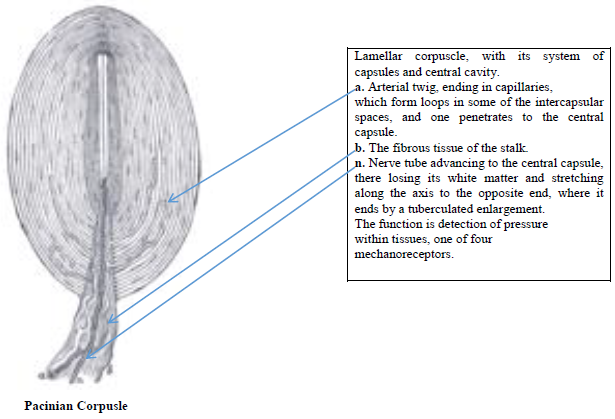
We are under a huge amount of atmospheric pressure, about 10,000 kg per square meter or 14.7 lbs per square inch. of skin and we don’t know this in our normal state of sensation. Our internal outward pressure counteracting this atmospheric pressure is what we call “blood pressure.” It must equal that pushing in or else we’ll compress to very little.
If you hold your arm out horizontal to gravity, skin bared, it is in balance with internal pressure pushing out and external pressure pushing in. You feel nothing, is that not so? Now, take a pointed object, like a sharp pencil and place it lightly on your skin in a vertical direction to your skin (parallel with gravity) and you’ll feel a very slight pressure. Take your hand holding the pencil and press it inward, slowly, into your skin. At a certain point you’ll saw ouch, to much pressure, it’s painful and release. The opposite is so if you take a suction cup on the skin and pull skyward, ouch, too much negative pressure thus your pain. What you identify as pain is a hydraulic pressure phenomenon playing upon the nervous system.
Pain is also a “concept” used for: 1) too much, or, 2) too little pressure. Reason for your tooth ache (subjective) is due to the infected “pressure” of a tooth that is under your gums along the tooth’s roots due to cutting away enamel (trauma), decomposition (decay), or clenching and grinding?fracturing. This triggers you feelings, your sensorial inputs and you say “ouch.”
Returning to our example of skin and pressure thereon, in a normal depolarize condition there is no sensation since there is no pressure. Only when disturbed, polarized, will nerve sensors in the tissues of the human body? mechanoreceptors?work on pressure input only.
Within the dental organ is a circulatory system as roughly depicted in Figure 1. The outward flow of fluids is to the external aspect of the dental organ, Odonton, which includes its supporting tissues. Without a deeper understanding of the mechanisms of tissue physiology, biology, chemo-electro-magnetic homeostasis, and the compelling inter-dependent relationship of these specific layers of the dental organ (tooth and supporting structures including proximal alveolar bone of its jaw segment) starting from the inward to the outward with: 1) alveolar bone, 2) periodontal ligament which contain “stem cells,” 3) cementum, 4) dentin, including it’s interstitial fluid known as dentinal fluid?dental lymph?nurturing the 5) odontoblasts, 6) type one collagen from fibroblasts within the pulp chamber, 7) and a plethora of normal dermal tissues enclosed in the pulp chamber such as lymph channels, venous and arterial channels, various nerve channels and endings, stem cells, and the normal complement of auto-immune protective cells such as lymphocytes, etc., all terminating with the 8) enamel sheath which interfaces the outward flow with the free oral environment. (Arrows in Figure 1).
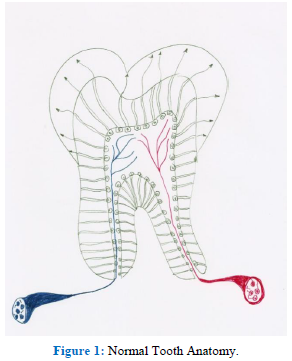
Figure 1: Normal Tooth Anatomy.
Normal anatomy of a tooth with internal blood, nerve supply with the tissue fluids flowing from the jaw through the tooth’s dentin to the outside of the enamel forming a light haze (plaque or bio-film) on the tooth’s surfaces that acts as protective shield for the tooth against any enamel decomposition. What is not seen here is the bone around the roots nor the secondary nervous system surrounding the tissues below the arrows that indicate the approximate position of bone a skin attachment to the odonton. An odonton is the entire tooth, supporting attachment apparatus and the bone about that tooth holding the tooth into place in the jaw. Here we have a lower molar tooth schematically represented.
Once the odonton’s (tooth’s) “dentine-pulp” complex?indicated area between the arrows in figure 1)?is compromised with micro-organisms, or its circulatory system degenerates, irreversible events occur leading to the death of the dental organ and gangrene.
In the early 20th Century the practice of “capping” or “doing a crown” for a tooth by shaving the exterior aspects into the dentine was unthinkable. However, as the art and science developed it became commonplace to “prepare” (reduce or cut away aspects of the tooth) the tooth for a full crown. (See Figure 2.) The idea of this philosophy of practice was to create a protective shield about the compromised dental organ ensuring its long life.
What was not yet understood, until the early 1990s though computer analysis, was that the trauma induced to the dental organ by cutting it radically led to its death by gangrene often. The circulatory system was damaged by our attempt in saving the dental organ. The ensuing degradation of the dentine-plup complex manifested as “apical bone defects” known technically as Apical Periodontitis? inflammatory infection in the bone since outward fluid flow was disrupted.
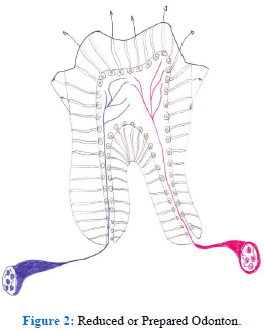
Figure 2: Reduced or Prepared Odonton.
In Figure 2. we express schematically the end resutls of what is called “tooth preparation” for capping a tooth. Here all of the eamel is removed that makes space for the “gold crown” in this instant case (See figure 3). Although conceptually a means to protect the dental organ it offten kills it.
Analogistically akin to stripping away the bark of a tree (the eamel being bark and cambium layer the dentine) the tooth eventually dies. Take away most or all of the bark of any tree and the tree will eventually die. This disruption of outward fluid flow or complete stopage thereof will stangulate the pulp-dentine fluid transport system from within to without the dental organ leading to internal corruption of the dental organ (death?gangrene) and its ensuing apical periodontist. At times, however, the capping procedures seem to work for years. Nonetheless, the mutilation of the dental organ will hasten its possible circulatory death?gangrene?that will normally be treated subsequently through “modern endodontics.”
From a view of biology and physiology this is an unwise move, for in essence it embalms the organ with myriad microorganisms that pontentially flow into the bone areas leading to oral system conditions such as Actiomycosis, forming mutiple body absecesses in the brain, neck, lungs and pelvic regions.
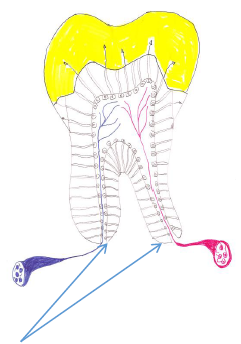
Apical periodontitis (dental alveolar abscesses) may occur usually here, but may occur anywhere along the root bone interfaces. The fundamental Principle to grasp is that of “cleansing.”
Figure 3: The “Gold Capped” Odonton.
Corrupted matter?thoughts also?will work toward expelling themselves in designed normal pathways, physiologically. If obstructions are installed or used, the process of “cleansing” is obstructed. That is the normal elimination of toxins (metabolites) is impeded and thus ensues greater concentration, crystallization, forming within tissues?“tumors.”
The tumors are protective devices prohibiting, as much as possible, the systemic dissemination of toxins. Yet, in time they become a focus of corruption needing remedial actions. In Figure 4. we see the end result of a capped tooth and the abscesses present at the root ends that were imbedded in the bone attachment of the lower jaw. The person who had this situation felt no pain, but what she called intermittent tenderness. Upon further inspection and her dental history a pus sack in which an apical periodontitis was evident.
The main body of the molar tooth separated from the "porcelain crown". The inside of the crown can be readily observed and the cut stub of the crown of the tooth shows the extent to which the tooth must be shaved to make a conventional crown, This trauma often causes an "irreversible gangrenous pulpitis."
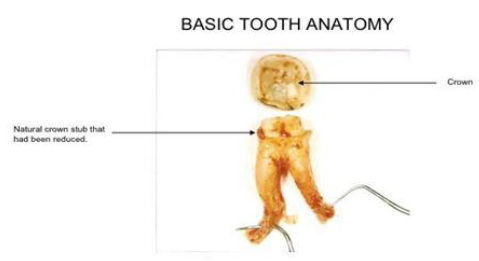
Figure 4: Abscessed Human Capped Odonton.
One of the primary micro-organisms resident in the pus sacs at the root tip end as seen in Figure 4. is actinomyces odontolyticus, a fungus like bacteria that avoids oxygen and once disseminated into the vascular system can easily locate (focate) in the brain, facial and neck area, lungs, abdomen, and pelvic region to establish colonies that generate abscesses in those tissues. The condition is “Actinomycosis” [1] and is more prevalent than reported due to the fact that testing for it in the laboratory cannot easily identify this type of bacteria.
The flora in a dead tooth of a recently “root canaled tooth” are numerous and work together to “cleanse” the tissue by decomposing it [2]. This “cleansing” process is first by liquefaction, then gas production, and finally phagocytosis (cellular eating of the toxic tissues). But the ultimate “cleanser” is God’s Divine Light[3] and secondly the dental surgeon who wisely removes this source of poison and its boney defect with cavitation surgery [4].
References
- Smergo RA, et al. Actinomycosis. Clinical Infectious Disease (1998).
- Nair PNR. Pathogenisis of Apical Periodontitis and The Causes of Endodontic Failures, Crit Rev Oral Biol Med 15 (2004): 348-381.
- Sukyo Mahikari North American Region, “Spritual Purification,” http://www.sukyomahikari.org
- Carlson RS. Endodontic-Endotoxemia: Our Current Dilemma. IABDM.


 Impact Factor: * 5.3
Impact Factor: * 5.3 Acceptance Rate: 75.63%
Acceptance Rate: 75.63%  Time to first decision: 10.4 days
Time to first decision: 10.4 days  Time from article received to acceptance: 2-3 weeks
Time from article received to acceptance: 2-3 weeks 
